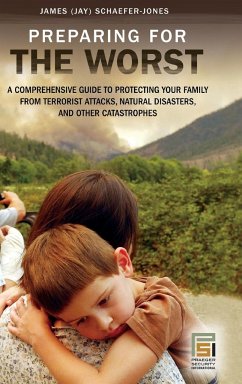James Jones
Preparing for the Worst
A Comprehensive Guide to Protecting Your Family from Terrorist Attacks, Natural Disasters, and Other Catastrophes
James Jones
Preparing for the Worst
A Comprehensive Guide to Protecting Your Family from Terrorist Attacks, Natural Disasters, and Other Catastrophes
- Gebundenes Buch
- Merkliste
- Auf die Merkliste
- Bewerten Bewerten
- Teilen
- Produkt teilen
- Produkterinnerung
- Produkterinnerung
Preparing for the Worst details the best practices in antiterrorism tactics and preparing for disaster. This book is for typical American families, business travelers, corporate executive management personnel, emergency first responders, school administrators, and local government officials responsible for public safety and emergency management. Americans are regularly bombarded with reports of disaster and tragedy in the daily news. Catastrophes like earthquakes, hurricanes, floods, violent crimes, and terrorism are so common and routine that many of us have become numb to the stories.…mehr
Andere Kunden interessierten sich auch für
![The 50 Worst Terrorist Attacks The 50 Worst Terrorist Attacks]() Edward MickolusThe 50 Worst Terrorist Attacks78,99 €
Edward MickolusThe 50 Worst Terrorist Attacks78,99 €![The Samurai preparing for the Dragon´s Attack? Normative Drivers and Strategic Foundations of Japan´s Security Cooperation with Australia and the United States The Samurai preparing for the Dragon´s Attack? Normative Drivers and Strategic Foundations of Japan´s Security Cooperation with Australia and the United States]() Hauke KlevinghausThe Samurai preparing for the Dragon´s Attack? Normative Drivers and Strategic Foundations of Japan´s Security Cooperation with Australia and the United States44,99 €
Hauke KlevinghausThe Samurai preparing for the Dragon´s Attack? Normative Drivers and Strategic Foundations of Japan´s Security Cooperation with Australia and the United States44,99 €![Preparing Women for Citizenship Preparing Women for Citizenship]() Helen Ring RobinsonPreparing Women for Citizenship31,99 €
Helen Ring RobinsonPreparing Women for Citizenship31,99 €![Preparing for World War III A Global Conflict That Redefines Tomorrow Preparing for World War III A Global Conflict That Redefines Tomorrow]() Lt. Col. Robert MaginnisPreparing for World War III A Global Conflict That Redefines Tomorrow26,99 €
Lt. Col. Robert MaginnisPreparing for World War III A Global Conflict That Redefines Tomorrow26,99 €![Our Own Worst Enemy?: Institutional Interests and the Proliferation of Nuclear Weapons Expertise Our Own Worst Enemy?: Institutional Interests and the Proliferation of Nuclear Weapons Expertise]() Sharon K. WeinerOur Own Worst Enemy?: Institutional Interests and the Proliferation of Nuclear Weapons Expertise13,99 €
Sharon K. WeinerOur Own Worst Enemy?: Institutional Interests and the Proliferation of Nuclear Weapons Expertise13,99 €![Best of Times, the Worst of Times, The: Maritime Security in the Asia-Pacific Best of Times, the Worst of Times, The: Maritime Security in the Asia-Pacific]() Best of Times, the Worst of Times, The: Maritime Security in the Asia-Pacific139,99 €
Best of Times, the Worst of Times, The: Maritime Security in the Asia-Pacific139,99 €![Africa's Best and Worst Presidents Africa's Best and Worst Presidents]() Nkwazi Nkuzi MhangoAfrica's Best and Worst Presidents51,99 €
Nkwazi Nkuzi MhangoAfrica's Best and Worst Presidents51,99 €-
-
-
Preparing for the Worst details the best practices in antiterrorism tactics and preparing for disaster. This book is for typical American families, business travelers, corporate executive management personnel, emergency first responders, school administrators, and local government officials responsible for public safety and emergency management. Americans are regularly bombarded with reports of disaster and tragedy in the daily news. Catastrophes like earthquakes, hurricanes, floods, violent crimes, and terrorism are so common and routine that many of us have become numb to the stories. Without a heightened awareness, focused concern, and effective planning, we have lost the edge that can save lives. Do you know what you should do to protect your family during a disaster? Does your neighbor have the knowledge required to survive a catastrophic event? Part of the solution is rooted in common sense, but much more depends upon effectively applying learned survival skills. Americans need a helpful reference tool-a Swiss army knife for handling today's threats. This book is that tool. A former U.S. Marine and Desert Storm veteran, Schaefer-Jones has experienced calamity firsthand. He is also a concerned husband and the father of three young children. While considering how he would personally handle a disastrous event close to home, he came to realize that a comprehensive how-to guide was not available-until now.
Hinweis: Dieser Artikel kann nur an eine deutsche Lieferadresse ausgeliefert werden.
Hinweis: Dieser Artikel kann nur an eine deutsche Lieferadresse ausgeliefert werden.
Produktdetails
- Produktdetails
- Verlag: Praeger
- Seitenzahl: 208
- Erscheinungstermin: 30. Juni 2007
- Englisch
- Abmessung: 240mm x 161mm x 16mm
- Gewicht: 482g
- ISBN-13: 9780275996314
- ISBN-10: 027599631X
- Artikelnr.: 26368117
- Herstellerkennzeichnung
- Libri GmbH
- Europaallee 1
- 36244 Bad Hersfeld
- gpsr@libri.de
- Verlag: Praeger
- Seitenzahl: 208
- Erscheinungstermin: 30. Juni 2007
- Englisch
- Abmessung: 240mm x 161mm x 16mm
- Gewicht: 482g
- ISBN-13: 9780275996314
- ISBN-10: 027599631X
- Artikelnr.: 26368117
- Herstellerkennzeichnung
- Libri GmbH
- Europaallee 1
- 36244 Bad Hersfeld
- gpsr@libri.de
James Jones served as Bishop of Hull (1994-98), Bishop of Liverpool (1998-2013), and Bishop to HM Prisons (2007-2013). He was appointed KBE in 2017 for services to the bereaved and to justice. He chaired the Hillsborough Independent Panel in 2009, the Independent Forestry Panel in 2012 and the Gosport Independent Panel in 2018. Bishop James is the author of With My Whole Heart and Jesus and the Earth (SPCK, 2012 and 2003 respectively).
Tables and Figures
Preface
Chapter 1 Why Prepare?
Using This Guide to Prepare
Chapter 2 Be Prepared: The Basics
Do Your Homework
Hazards
Warning Systems and Signals
Evacuating Yourself and Your Family
Community and Other Plans
School Emergency Plans
Workplace Plans
Emergency Planning and Checklists
Escape Routes
Family Communications
Utility Shutoff and Safety
Insurance and Vital Records
Special Needs
Caring for Animals
Safety Skills
Assemble a Disaster Supplies Kit
Kit Locations
Water
Food
Basic Disaster Supplies Kit
Maintaining Your Disaster Supplies Kit
Shelter
Managing Water
Managing Food Supplies
Hazard-Specific Preparedness
Other Considerations in the Wake of a Disaster
Volunteer-Responder Convergence
Peripheral Hazards
Practicing and Maintaining Your Plan
Chapter 3 Resources for More Information
International
U.S. Federal Government
State and Local Authorities
Commercial and Others
Chapter 4 Natural Hazards
Earthquakes
Know the Terms
Take Protective Measures
Fires
Classification of Fires
Take Protective Measures
Floods
Know the Terms
Take Protective Measures
Extreme Heat
Know the Terms
Take Protective Measures
First Aid for Heat-Induced Illnesses
Additional Information
Hurricanes
Know the Terms
Take Protective Measures
Landslides and Mudslides
Take Protective Measures
Thunderstorms and Lightning
Know the Terms
Take Protective Measures
Tornadoes
Know the Terms
Take Protective Measures
Tsunamis
Know the Terms
Take Protective Measures
Volcanoes
Take Protective Measures
Wildfires
Take Protective Measures
Winter Storms and Extreme Cold
Know the Terms
Take Protective Measures
Pandemics
Know the Terms
Take Protective Measures
Other Disease Threats
Take Protective Measures
If You Suspect that You Might Be Infected
Chapter 5 Technological Hazards
Hazardous Materials Incidents
Take Protective Measures
Household Chemical Emergencies
Take Protective Measures
Nuclear Power Plant Emergencies
Minimizing Exposure to Radiation
Know the Terms
Take Protective Measures
Chapter 6 Terrorism
General Information about Terrorism
Homeland Security Advisory System
Threat Conditions and Associated Protective Measures
Bomb Threats or Explosions
Take Protective Measures
Biological Threats
Take Protective Measures
Chemical Threats
Take Protective Measures
Nuclear Threats
Hazards of Nuclear Devices
Take Protective Measures
Radiological Dispersion Device (RDD) Threats
Take Protective Measures
Personal Antiterrorism Measures
Identifying the Threat
Limiting Visibility
Physical Security
Travel
Detecting Surveillance
Attack Recognition
Incident Reaction
Cyber-Terrorism and Identity Theft
Cyber-Terrorism
Identity Theft
Chapter 7 Recovering from Disaster
Health and Safety Guidelines
Aiding the Injured
Health
Safety Issues
Returning Home
Before You Enter Your Home
Going Inside Your Home
Being Wary of Wildlife and Other Animals
Seeking Disaster Assistance
Direct Assistance
The Federal Role
Coping with Disaster
Understand Disaster Events
Recognize Signs of Disaster-Related Stress
Easing Disaster-Related Stress
Helping Children Cope with Disaster
Monitor and Limit Your Family's Exposure to the Media
Use Support Networks
Helping Others
Appendix A: Water Conservation Tips
Indoor Water Conservation Tips
General
Bathroom
Kitchen
Laundry
Outdoor Water Conservation Tips
General
Car Washing
Lawn Care
Pool
Appendix B: Disaster Supplies Checklists
First-Aid Supplies
Nonprescription and Prescription Medicine Kit Supplies
Sanitation and Hygiene Supplies
Tools and Equipment
Food and Water
Clothes and Bedding Supplies
Vital Information
Appendix C: First Aid in an NBC Environment
General
NBC First-Aid Materials
Classification of Chemical and Biological Agents
Conditions that May Signal a Chemical or Biological Attack
First Aid for a Chemical Attack
Nerve Agents
Signs and Symptoms of Nerve Agent Poisoning
First Aid for Nerve Agent Poisoning
Blister Agents
Protective Measures
Signs and Symptoms of Blister Agent Poisoning
First-Aid Measures for Blister Agent Poisoning
Choking Agents (Lung-Damaging Agents)
Protective Measures
Signs and Symptoms of Choking Agents
Self-Aid
Cyanogen (Blood) Agents
Protective Measures
Signs and Symptoms of Cyanogen Agent Poisoning
First Aid for Cyanogen Agent Poisoning
Incapacitating Agents and First Aid
Incendiary Agents and First Aid
Biological Agents and First Aid
Toxins
Signs and Symptoms of Toxin Exposure
Self-Aid for Toxin Exposure
Nuclear Detonation, RDD Events, or Nuclear Reactor Accidents
Appendix D: Disaster Planning for Pets and Livestock
General
Planning for Domestic Pets
Before a Disaster
During a Disaster
After a Disaster
Planning for Horses, Large Animals, and Livestock
Before a Disaster
During a Disaster
After a Disaster
Appendix E: Evacuating Mass Transit
General
Emergencies on a Train or a Subway Car
Types of Emergencies
Before a Disaster
During a Disaster
After a Disaster Evacuation
Emergencies on a School (or Commuter) Bus
Before a Disaster
During a Disaster
After a Disaster Evacuation
Emergencies on an Airplane
Before a Disaster
During a Disaster
After a Disaster Evacuation
Appendix F: Sheltering in Place
Take Protective Measures
Before a Disaster
During a Disaster
After a Disaster
Appendix G: Emergency Communications
9-1-1
2-1-1
Citizen's Band (CB)
49 MHz Personal Radios
Family Radio Service (FRS) 179
General Mobile Radio Service (GMRS)
Multiuse Radio Service (MURS)
Amateur Radio Service (Ham Radio)
Scanners
Global Positioning System (GPS)
Emergency Alert System (EAS)
Emergency Weather Receivers
Personal Locator Beacons (PLB)
Emergency Family Communications Plan
Index
Preface
Chapter 1 Why Prepare?
Using This Guide to Prepare
Chapter 2 Be Prepared: The Basics
Do Your Homework
Hazards
Warning Systems and Signals
Evacuating Yourself and Your Family
Community and Other Plans
School Emergency Plans
Workplace Plans
Emergency Planning and Checklists
Escape Routes
Family Communications
Utility Shutoff and Safety
Insurance and Vital Records
Special Needs
Caring for Animals
Safety Skills
Assemble a Disaster Supplies Kit
Kit Locations
Water
Food
Basic Disaster Supplies Kit
Maintaining Your Disaster Supplies Kit
Shelter
Managing Water
Managing Food Supplies
Hazard-Specific Preparedness
Other Considerations in the Wake of a Disaster
Volunteer-Responder Convergence
Peripheral Hazards
Practicing and Maintaining Your Plan
Chapter 3 Resources for More Information
International
U.S. Federal Government
State and Local Authorities
Commercial and Others
Chapter 4 Natural Hazards
Earthquakes
Know the Terms
Take Protective Measures
Fires
Classification of Fires
Take Protective Measures
Floods
Know the Terms
Take Protective Measures
Extreme Heat
Know the Terms
Take Protective Measures
First Aid for Heat-Induced Illnesses
Additional Information
Hurricanes
Know the Terms
Take Protective Measures
Landslides and Mudslides
Take Protective Measures
Thunderstorms and Lightning
Know the Terms
Take Protective Measures
Tornadoes
Know the Terms
Take Protective Measures
Tsunamis
Know the Terms
Take Protective Measures
Volcanoes
Take Protective Measures
Wildfires
Take Protective Measures
Winter Storms and Extreme Cold
Know the Terms
Take Protective Measures
Pandemics
Know the Terms
Take Protective Measures
Other Disease Threats
Take Protective Measures
If You Suspect that You Might Be Infected
Chapter 5 Technological Hazards
Hazardous Materials Incidents
Take Protective Measures
Household Chemical Emergencies
Take Protective Measures
Nuclear Power Plant Emergencies
Minimizing Exposure to Radiation
Know the Terms
Take Protective Measures
Chapter 6 Terrorism
General Information about Terrorism
Homeland Security Advisory System
Threat Conditions and Associated Protective Measures
Bomb Threats or Explosions
Take Protective Measures
Biological Threats
Take Protective Measures
Chemical Threats
Take Protective Measures
Nuclear Threats
Hazards of Nuclear Devices
Take Protective Measures
Radiological Dispersion Device (RDD) Threats
Take Protective Measures
Personal Antiterrorism Measures
Identifying the Threat
Limiting Visibility
Physical Security
Travel
Detecting Surveillance
Attack Recognition
Incident Reaction
Cyber-Terrorism and Identity Theft
Cyber-Terrorism
Identity Theft
Chapter 7 Recovering from Disaster
Health and Safety Guidelines
Aiding the Injured
Health
Safety Issues
Returning Home
Before You Enter Your Home
Going Inside Your Home
Being Wary of Wildlife and Other Animals
Seeking Disaster Assistance
Direct Assistance
The Federal Role
Coping with Disaster
Understand Disaster Events
Recognize Signs of Disaster-Related Stress
Easing Disaster-Related Stress
Helping Children Cope with Disaster
Monitor and Limit Your Family's Exposure to the Media
Use Support Networks
Helping Others
Appendix A: Water Conservation Tips
Indoor Water Conservation Tips
General
Bathroom
Kitchen
Laundry
Outdoor Water Conservation Tips
General
Car Washing
Lawn Care
Pool
Appendix B: Disaster Supplies Checklists
First-Aid Supplies
Nonprescription and Prescription Medicine Kit Supplies
Sanitation and Hygiene Supplies
Tools and Equipment
Food and Water
Clothes and Bedding Supplies
Vital Information
Appendix C: First Aid in an NBC Environment
General
NBC First-Aid Materials
Classification of Chemical and Biological Agents
Conditions that May Signal a Chemical or Biological Attack
First Aid for a Chemical Attack
Nerve Agents
Signs and Symptoms of Nerve Agent Poisoning
First Aid for Nerve Agent Poisoning
Blister Agents
Protective Measures
Signs and Symptoms of Blister Agent Poisoning
First-Aid Measures for Blister Agent Poisoning
Choking Agents (Lung-Damaging Agents)
Protective Measures
Signs and Symptoms of Choking Agents
Self-Aid
Cyanogen (Blood) Agents
Protective Measures
Signs and Symptoms of Cyanogen Agent Poisoning
First Aid for Cyanogen Agent Poisoning
Incapacitating Agents and First Aid
Incendiary Agents and First Aid
Biological Agents and First Aid
Toxins
Signs and Symptoms of Toxin Exposure
Self-Aid for Toxin Exposure
Nuclear Detonation, RDD Events, or Nuclear Reactor Accidents
Appendix D: Disaster Planning for Pets and Livestock
General
Planning for Domestic Pets
Before a Disaster
During a Disaster
After a Disaster
Planning for Horses, Large Animals, and Livestock
Before a Disaster
During a Disaster
After a Disaster
Appendix E: Evacuating Mass Transit
General
Emergencies on a Train or a Subway Car
Types of Emergencies
Before a Disaster
During a Disaster
After a Disaster Evacuation
Emergencies on a School (or Commuter) Bus
Before a Disaster
During a Disaster
After a Disaster Evacuation
Emergencies on an Airplane
Before a Disaster
During a Disaster
After a Disaster Evacuation
Appendix F: Sheltering in Place
Take Protective Measures
Before a Disaster
During a Disaster
After a Disaster
Appendix G: Emergency Communications
9-1-1
2-1-1
Citizen's Band (CB)
49 MHz Personal Radios
Family Radio Service (FRS) 179
General Mobile Radio Service (GMRS)
Multiuse Radio Service (MURS)
Amateur Radio Service (Ham Radio)
Scanners
Global Positioning System (GPS)
Emergency Alert System (EAS)
Emergency Weather Receivers
Personal Locator Beacons (PLB)
Emergency Family Communications Plan
Index
Tables and Figures
Preface
Chapter 1 Why Prepare?
Using This Guide to Prepare
Chapter 2 Be Prepared: The Basics
Do Your Homework
Hazards
Warning Systems and Signals
Evacuating Yourself and Your Family
Community and Other Plans
School Emergency Plans
Workplace Plans
Emergency Planning and Checklists
Escape Routes
Family Communications
Utility Shutoff and Safety
Insurance and Vital Records
Special Needs
Caring for Animals
Safety Skills
Assemble a Disaster Supplies Kit
Kit Locations
Water
Food
Basic Disaster Supplies Kit
Maintaining Your Disaster Supplies Kit
Shelter
Managing Water
Managing Food Supplies
Hazard-Specific Preparedness
Other Considerations in the Wake of a Disaster
Volunteer-Responder Convergence
Peripheral Hazards
Practicing and Maintaining Your Plan
Chapter 3 Resources for More Information
International
U.S. Federal Government
State and Local Authorities
Commercial and Others
Chapter 4 Natural Hazards
Earthquakes
Know the Terms
Take Protective Measures
Fires
Classification of Fires
Take Protective Measures
Floods
Know the Terms
Take Protective Measures
Extreme Heat
Know the Terms
Take Protective Measures
First Aid for Heat-Induced Illnesses
Additional Information
Hurricanes
Know the Terms
Take Protective Measures
Landslides and Mudslides
Take Protective Measures
Thunderstorms and Lightning
Know the Terms
Take Protective Measures
Tornadoes
Know the Terms
Take Protective Measures
Tsunamis
Know the Terms
Take Protective Measures
Volcanoes
Take Protective Measures
Wildfires
Take Protective Measures
Winter Storms and Extreme Cold
Know the Terms
Take Protective Measures
Pandemics
Know the Terms
Take Protective Measures
Other Disease Threats
Take Protective Measures
If You Suspect that You Might Be Infected
Chapter 5 Technological Hazards
Hazardous Materials Incidents
Take Protective Measures
Household Chemical Emergencies
Take Protective Measures
Nuclear Power Plant Emergencies
Minimizing Exposure to Radiation
Know the Terms
Take Protective Measures
Chapter 6 Terrorism
General Information about Terrorism
Homeland Security Advisory System
Threat Conditions and Associated Protective Measures
Bomb Threats or Explosions
Take Protective Measures
Biological Threats
Take Protective Measures
Chemical Threats
Take Protective Measures
Nuclear Threats
Hazards of Nuclear Devices
Take Protective Measures
Radiological Dispersion Device (RDD) Threats
Take Protective Measures
Personal Antiterrorism Measures
Identifying the Threat
Limiting Visibility
Physical Security
Travel
Detecting Surveillance
Attack Recognition
Incident Reaction
Cyber-Terrorism and Identity Theft
Cyber-Terrorism
Identity Theft
Chapter 7 Recovering from Disaster
Health and Safety Guidelines
Aiding the Injured
Health
Safety Issues
Returning Home
Before You Enter Your Home
Going Inside Your Home
Being Wary of Wildlife and Other Animals
Seeking Disaster Assistance
Direct Assistance
The Federal Role
Coping with Disaster
Understand Disaster Events
Recognize Signs of Disaster-Related Stress
Easing Disaster-Related Stress
Helping Children Cope with Disaster
Monitor and Limit Your Family's Exposure to the Media
Use Support Networks
Helping Others
Appendix A: Water Conservation Tips
Indoor Water Conservation Tips
General
Bathroom
Kitchen
Laundry
Outdoor Water Conservation Tips
General
Car Washing
Lawn Care
Pool
Appendix B: Disaster Supplies Checklists
First-Aid Supplies
Nonprescription and Prescription Medicine Kit Supplies
Sanitation and Hygiene Supplies
Tools and Equipment
Food and Water
Clothes and Bedding Supplies
Vital Information
Appendix C: First Aid in an NBC Environment
General
NBC First-Aid Materials
Classification of Chemical and Biological Agents
Conditions that May Signal a Chemical or Biological Attack
First Aid for a Chemical Attack
Nerve Agents
Signs and Symptoms of Nerve Agent Poisoning
First Aid for Nerve Agent Poisoning
Blister Agents
Protective Measures
Signs and Symptoms of Blister Agent Poisoning
First-Aid Measures for Blister Agent Poisoning
Choking Agents (Lung-Damaging Agents)
Protective Measures
Signs and Symptoms of Choking Agents
Self-Aid
Cyanogen (Blood) Agents
Protective Measures
Signs and Symptoms of Cyanogen Agent Poisoning
First Aid for Cyanogen Agent Poisoning
Incapacitating Agents and First Aid
Incendiary Agents and First Aid
Biological Agents and First Aid
Toxins
Signs and Symptoms of Toxin Exposure
Self-Aid for Toxin Exposure
Nuclear Detonation, RDD Events, or Nuclear Reactor Accidents
Appendix D: Disaster Planning for Pets and Livestock
General
Planning for Domestic Pets
Before a Disaster
During a Disaster
After a Disaster
Planning for Horses, Large Animals, and Livestock
Before a Disaster
During a Disaster
After a Disaster
Appendix E: Evacuating Mass Transit
General
Emergencies on a Train or a Subway Car
Types of Emergencies
Before a Disaster
During a Disaster
After a Disaster Evacuation
Emergencies on a School (or Commuter) Bus
Before a Disaster
During a Disaster
After a Disaster Evacuation
Emergencies on an Airplane
Before a Disaster
During a Disaster
After a Disaster Evacuation
Appendix F: Sheltering in Place
Take Protective Measures
Before a Disaster
During a Disaster
After a Disaster
Appendix G: Emergency Communications
9-1-1
2-1-1
Citizen's Band (CB)
49 MHz Personal Radios
Family Radio Service (FRS) 179
General Mobile Radio Service (GMRS)
Multiuse Radio Service (MURS)
Amateur Radio Service (Ham Radio)
Scanners
Global Positioning System (GPS)
Emergency Alert System (EAS)
Emergency Weather Receivers
Personal Locator Beacons (PLB)
Emergency Family Communications Plan
Index
Preface
Chapter 1 Why Prepare?
Using This Guide to Prepare
Chapter 2 Be Prepared: The Basics
Do Your Homework
Hazards
Warning Systems and Signals
Evacuating Yourself and Your Family
Community and Other Plans
School Emergency Plans
Workplace Plans
Emergency Planning and Checklists
Escape Routes
Family Communications
Utility Shutoff and Safety
Insurance and Vital Records
Special Needs
Caring for Animals
Safety Skills
Assemble a Disaster Supplies Kit
Kit Locations
Water
Food
Basic Disaster Supplies Kit
Maintaining Your Disaster Supplies Kit
Shelter
Managing Water
Managing Food Supplies
Hazard-Specific Preparedness
Other Considerations in the Wake of a Disaster
Volunteer-Responder Convergence
Peripheral Hazards
Practicing and Maintaining Your Plan
Chapter 3 Resources for More Information
International
U.S. Federal Government
State and Local Authorities
Commercial and Others
Chapter 4 Natural Hazards
Earthquakes
Know the Terms
Take Protective Measures
Fires
Classification of Fires
Take Protective Measures
Floods
Know the Terms
Take Protective Measures
Extreme Heat
Know the Terms
Take Protective Measures
First Aid for Heat-Induced Illnesses
Additional Information
Hurricanes
Know the Terms
Take Protective Measures
Landslides and Mudslides
Take Protective Measures
Thunderstorms and Lightning
Know the Terms
Take Protective Measures
Tornadoes
Know the Terms
Take Protective Measures
Tsunamis
Know the Terms
Take Protective Measures
Volcanoes
Take Protective Measures
Wildfires
Take Protective Measures
Winter Storms and Extreme Cold
Know the Terms
Take Protective Measures
Pandemics
Know the Terms
Take Protective Measures
Other Disease Threats
Take Protective Measures
If You Suspect that You Might Be Infected
Chapter 5 Technological Hazards
Hazardous Materials Incidents
Take Protective Measures
Household Chemical Emergencies
Take Protective Measures
Nuclear Power Plant Emergencies
Minimizing Exposure to Radiation
Know the Terms
Take Protective Measures
Chapter 6 Terrorism
General Information about Terrorism
Homeland Security Advisory System
Threat Conditions and Associated Protective Measures
Bomb Threats or Explosions
Take Protective Measures
Biological Threats
Take Protective Measures
Chemical Threats
Take Protective Measures
Nuclear Threats
Hazards of Nuclear Devices
Take Protective Measures
Radiological Dispersion Device (RDD) Threats
Take Protective Measures
Personal Antiterrorism Measures
Identifying the Threat
Limiting Visibility
Physical Security
Travel
Detecting Surveillance
Attack Recognition
Incident Reaction
Cyber-Terrorism and Identity Theft
Cyber-Terrorism
Identity Theft
Chapter 7 Recovering from Disaster
Health and Safety Guidelines
Aiding the Injured
Health
Safety Issues
Returning Home
Before You Enter Your Home
Going Inside Your Home
Being Wary of Wildlife and Other Animals
Seeking Disaster Assistance
Direct Assistance
The Federal Role
Coping with Disaster
Understand Disaster Events
Recognize Signs of Disaster-Related Stress
Easing Disaster-Related Stress
Helping Children Cope with Disaster
Monitor and Limit Your Family's Exposure to the Media
Use Support Networks
Helping Others
Appendix A: Water Conservation Tips
Indoor Water Conservation Tips
General
Bathroom
Kitchen
Laundry
Outdoor Water Conservation Tips
General
Car Washing
Lawn Care
Pool
Appendix B: Disaster Supplies Checklists
First-Aid Supplies
Nonprescription and Prescription Medicine Kit Supplies
Sanitation and Hygiene Supplies
Tools and Equipment
Food and Water
Clothes and Bedding Supplies
Vital Information
Appendix C: First Aid in an NBC Environment
General
NBC First-Aid Materials
Classification of Chemical and Biological Agents
Conditions that May Signal a Chemical or Biological Attack
First Aid for a Chemical Attack
Nerve Agents
Signs and Symptoms of Nerve Agent Poisoning
First Aid for Nerve Agent Poisoning
Blister Agents
Protective Measures
Signs and Symptoms of Blister Agent Poisoning
First-Aid Measures for Blister Agent Poisoning
Choking Agents (Lung-Damaging Agents)
Protective Measures
Signs and Symptoms of Choking Agents
Self-Aid
Cyanogen (Blood) Agents
Protective Measures
Signs and Symptoms of Cyanogen Agent Poisoning
First Aid for Cyanogen Agent Poisoning
Incapacitating Agents and First Aid
Incendiary Agents and First Aid
Biological Agents and First Aid
Toxins
Signs and Symptoms of Toxin Exposure
Self-Aid for Toxin Exposure
Nuclear Detonation, RDD Events, or Nuclear Reactor Accidents
Appendix D: Disaster Planning for Pets and Livestock
General
Planning for Domestic Pets
Before a Disaster
During a Disaster
After a Disaster
Planning for Horses, Large Animals, and Livestock
Before a Disaster
During a Disaster
After a Disaster
Appendix E: Evacuating Mass Transit
General
Emergencies on a Train or a Subway Car
Types of Emergencies
Before a Disaster
During a Disaster
After a Disaster Evacuation
Emergencies on a School (or Commuter) Bus
Before a Disaster
During a Disaster
After a Disaster Evacuation
Emergencies on an Airplane
Before a Disaster
During a Disaster
After a Disaster Evacuation
Appendix F: Sheltering in Place
Take Protective Measures
Before a Disaster
During a Disaster
After a Disaster
Appendix G: Emergency Communications
9-1-1
2-1-1
Citizen's Band (CB)
49 MHz Personal Radios
Family Radio Service (FRS) 179
General Mobile Radio Service (GMRS)
Multiuse Radio Service (MURS)
Amateur Radio Service (Ham Radio)
Scanners
Global Positioning System (GPS)
Emergency Alert System (EAS)
Emergency Weather Receivers
Personal Locator Beacons (PLB)
Emergency Family Communications Plan
Index









